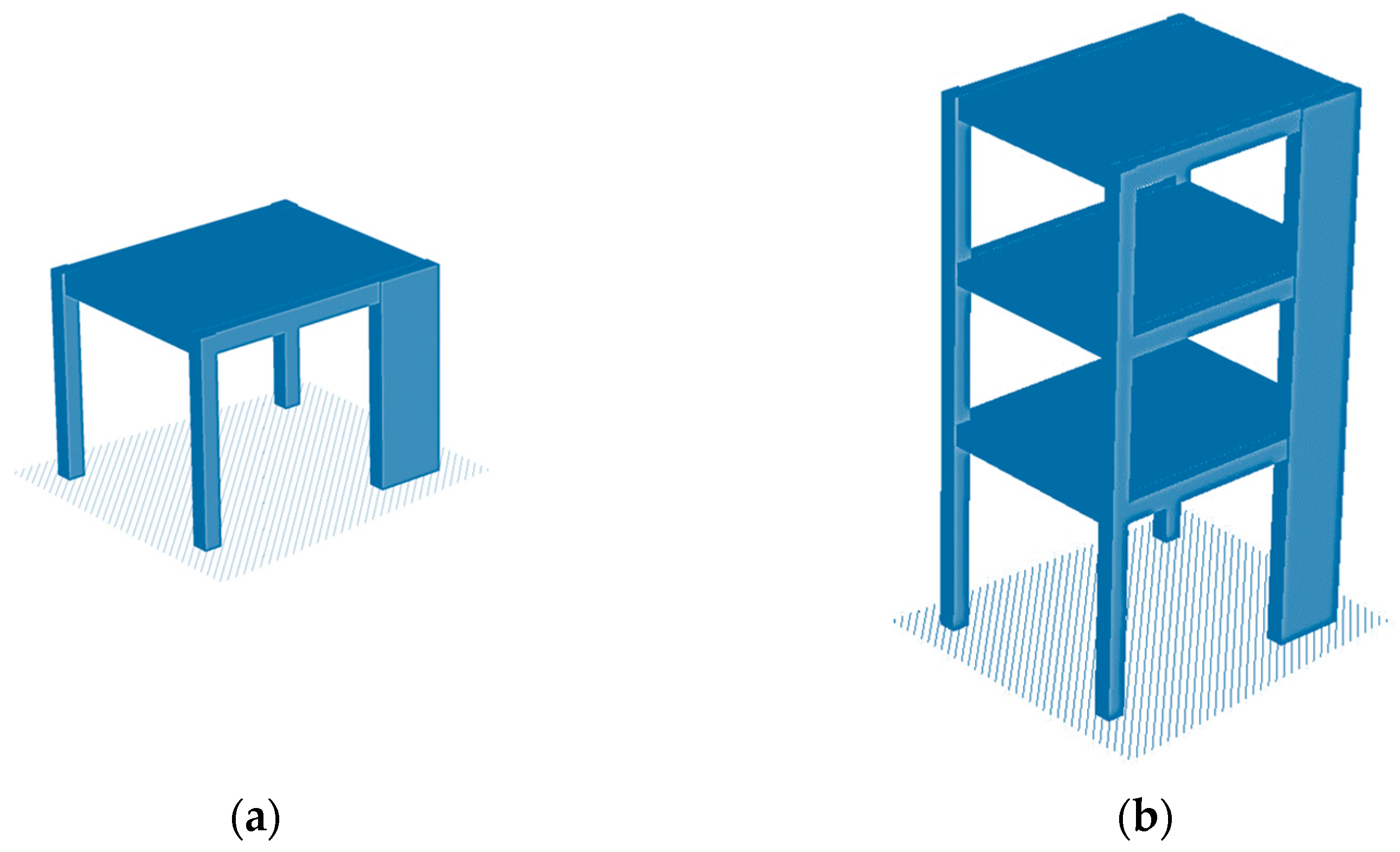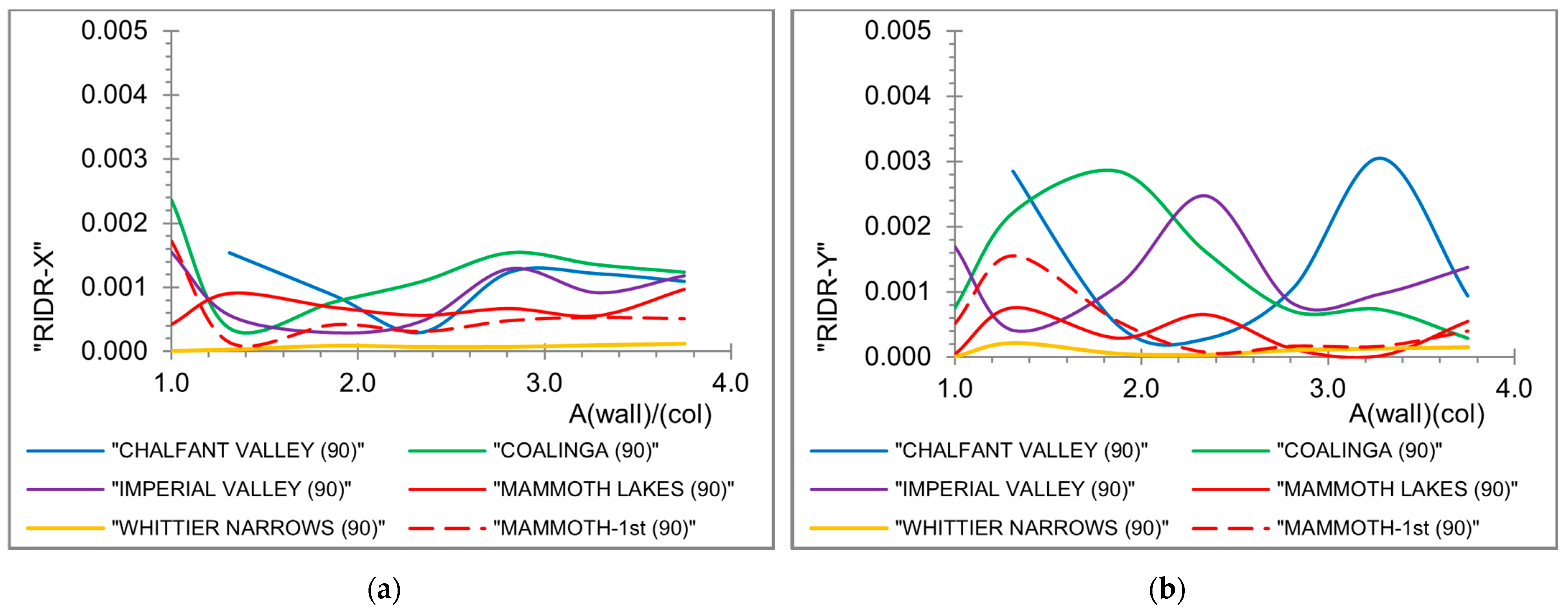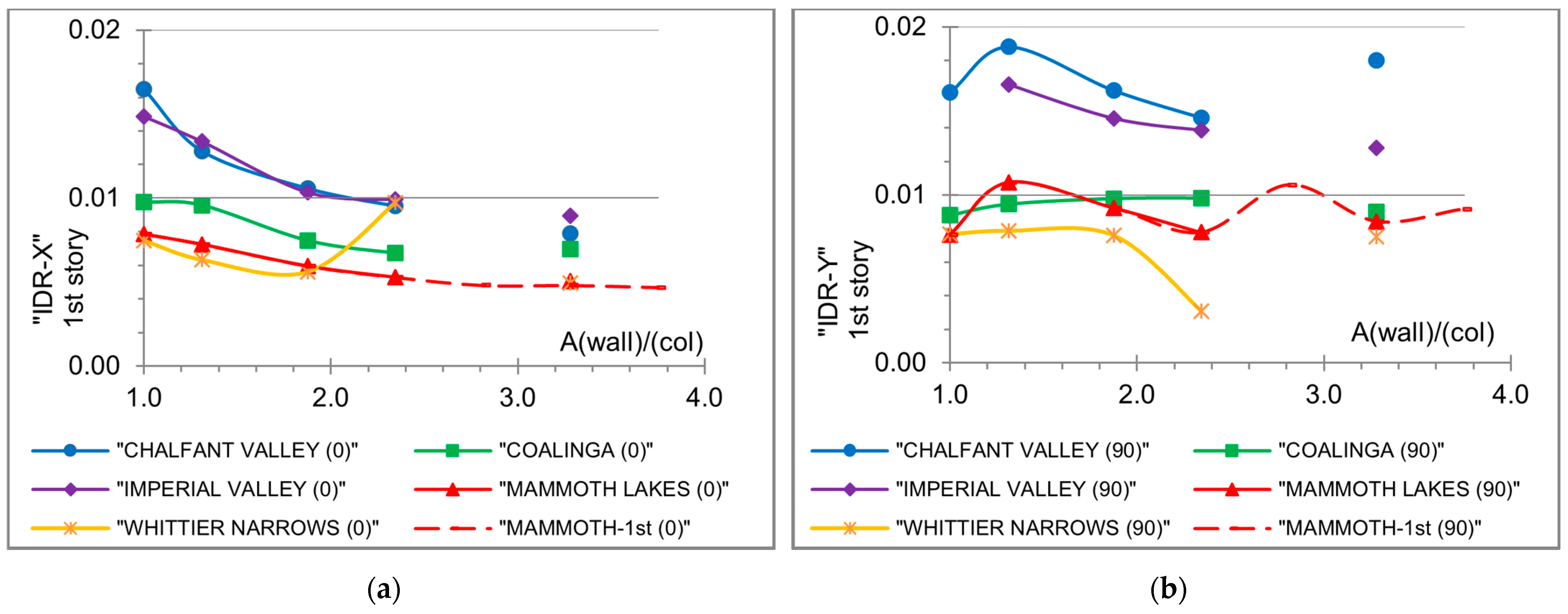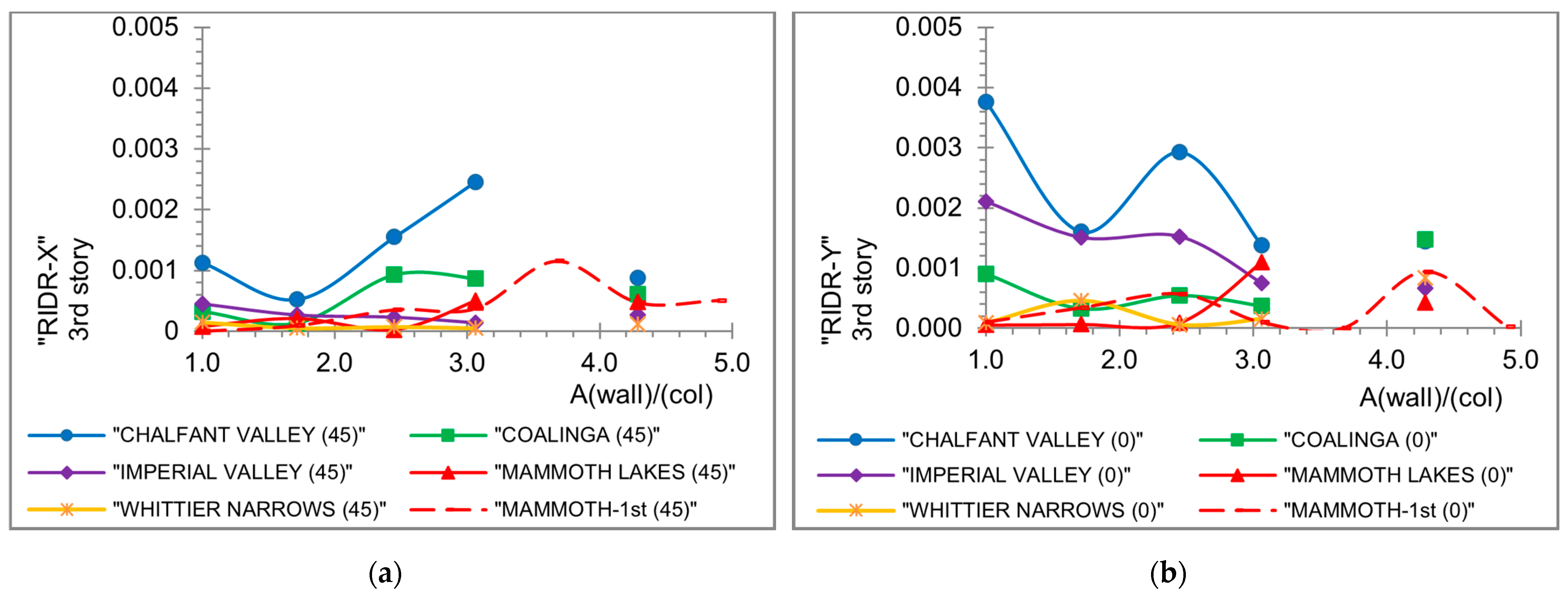Research on Asymmetrical Reinforced Concrete Low-Rise Frames under Multiple Seismic Events †
Abstract
:1. Introduction
2. Description of Frames and Analysis
3. Seismic Response Results
3.1. One-Story Frames
3.2. Three-Story Frames
4. Conclusions
- (1)
- The IDR increases with larger wall sections and for higher building frames. In general, the IDR charts tend to have a value range inside the allowed limits of the present seismic regulations.
- (2)
- The RIDR charts have a general value range inside the allowed constraints of the applicable regulations. The RIDR values for the Y axis are noticed as greater than the corresponding ones for the X axis.
- (3)
- The direction of the ground excitation influences the seismic response characteristics, while the selected values of 0°, 45° and 90° are identical for the definition of the most detrimental response values.
- (4)
- Multiple seismic events tend to deteriorate the strength of RC frames.
- (5)
- The framed constructions with large wall cross-sections, i.e., greater than the “wall” limit section of present provisions, as well as the symmetrical buildings, are vulnerable to multiple seismic events, in contrast to a single seismic excitation.
Funding
Institutional Review Board Statement
Informed Consent Statement
Data Availability Statement
Conflicts of Interest
References
- Rutenberg, A. Nonlinear Seismic Analysis and Design of Reinforced Concrete Buildings, 1st ed.; Fajfar, P., Krawinkler, H., Eds.; Elsevier Science Publishers Ltd.: Essex, UK, 1992; pp. 328–355. [Google Scholar]
- Goel, R.K.; Chopra, A.K. Effects of plan asymmetry in inelastic seismic response of one-story systems. J. Struct. Eng. 1991, 117, 1492–1513. [Google Scholar] [CrossRef]
- Bento, R.; De Stefano, M.; Köber, D.; Zembaty, Z. Seismic Behaviour and Design of Irregular and Complex Civil Structures IV, 1st ed.; Springer Nature: Cham, Switzerland, 2022. [Google Scholar]
- Eurocode 2 (EC2); Design of Concrete Structures-Part 1-1: General Rules and Rules for Buildings. European Committee for Standardization (CEN): Brussels, Belgium, 2004.
- Eurocode 8 (EC8); Design of Structures for Earthquake Resistance—Part 1: General Rules, Seismic Actions and Rules for Buildings, Part 3: Strengthening and Repair of Buildings, Part 5: Foundations, Retaining Structures and Geotechnical Aspects. Part 6: Towers, Masts and Chimneys. European Committee for Standardization: Brussels, Belgium, 2004.
- Hatzigeorgiou, G.D.; Beskos, D.E. Inelastic displacement ratios for SDOF structures subjected to repeated earthquakes. Eng. Struct. 2009, 31, 2744–2755. [Google Scholar] [CrossRef]
- Hatzigeorgiou, G.D.; Liolios, A.A. Nonlinear behaviour of RC frames under repeated strong ground motions. Soil Dyn. Earthq. Eng. 2010, 30, 1010–1025. [Google Scholar] [CrossRef]
- Lazaridis, P.C.; Kavvadias, I.E.; Demertzis, K.; Iliadis, L.; Vasiliadis, L.K. Structural Damage Prediction of a Reinforced Concrete Frame under Single and Multiple Seismic Events Using Machine Learning Algorithms. Appl. Sci. 2022, 12, 3845. [Google Scholar] [CrossRef]
- Eurocode 1 (EC1); Actions on Structures-Part 1-1: General Actions, Densities, Self-Weight, Imposed Loads for Buildings. European Committee for Standardization (CEN): Brussels, Belgium, 2001.
- Askouni, P.K. The Effect of Sequential Excitations on Asymmetrical Reinforced Concrete Low-Rise Framed Structures. Symmetry 2023, 15, 968. [Google Scholar] [CrossRef]
- ETABS. Integrated Building Design Software; Computers and Structures Inc. CSI.: Berkeley, CA, USA, 2015. [Google Scholar]
- Pacific Earthquake Engineering Research Center (PEER): Strong Motion Database. Available online: https://ngawest2.berkeley.edu/ (accessed on 10 September 2022).
- Rigato, A.B.; Medina, R.A. Influence of angle of incidence on seismic demands for inelastic single-storey structures subjected to bi-directional ground motions. Eng. Struct. 2007, 29, 2593–2601. [Google Scholar] [CrossRef]
- Sfakianakis, M.G.; Fardis, M.N. Nonlinear finite element for modeling reinforced concrete columns in three-dimensional dynamic analysis. Comput. Struct. 1991, 40, 1405–1419. [Google Scholar] [CrossRef]
- Sfakianakis, M.G. Computation of Yield and Failure Surfaces for Biaxial Bending with Axial Force of Reinforced Concrete Sections with Jackets. In Proceedings of the 15 WCEE2012, Lisbon, Portugal, 24–28 September 2012. [Google Scholar]
- FEMA-356; Prestandard and Commentary for the Seismic Rehabilitation of Buildings. Federal Emergency Management Agency: Washington, DC, USA, 2000. Available online: https://www.nehrp.gov/pdf/fema356.pdf (accessed on 10 September 2020).








Disclaimer/Publisher’s Note: The statements, opinions and data contained in all publications are solely those of the individual author(s) and contributor(s) and not of MDPI and/or the editor(s). MDPI and/or the editor(s) disclaim responsibility for any injury to people or property resulting from any ideas, methods, instructions or products referred to in the content. |
© 2023 by the author. Licensee MDPI, Basel, Switzerland. This article is an open access article distributed under the terms and conditions of the Creative Commons Attribution (CC BY) license (https://creativecommons.org/licenses/by/4.0/).
Share and Cite
Askouni, P.K. Research on Asymmetrical Reinforced Concrete Low-Rise Frames under Multiple Seismic Events. Eng. Proc. 2023, 53, 29. https://doi.org/10.3390/IOCBD2023-15191
Askouni PK. Research on Asymmetrical Reinforced Concrete Low-Rise Frames under Multiple Seismic Events. Engineering Proceedings. 2023; 53(1):29. https://doi.org/10.3390/IOCBD2023-15191
Chicago/Turabian StyleAskouni, Paraskevi K. 2023. "Research on Asymmetrical Reinforced Concrete Low-Rise Frames under Multiple Seismic Events" Engineering Proceedings 53, no. 1: 29. https://doi.org/10.3390/IOCBD2023-15191
APA StyleAskouni, P. K. (2023). Research on Asymmetrical Reinforced Concrete Low-Rise Frames under Multiple Seismic Events. Engineering Proceedings, 53(1), 29. https://doi.org/10.3390/IOCBD2023-15191





